We head back across the pond for the latest instalment of our “Lost Trams” series as we take a look at Leeds Feltham 526 which has been in the United States for over 50 years since it was exported in 1960 after withdrawal from its second tram system in the UK. Jamie Guest from the Leeds Transport Historical Society provides us with a look at the tram.
Recently four members of the Leeds Transport Historical Society undertook a research trip to the USA to gather information about Stephenson cars with a view to possibly building a replica of a ‘Roundhay Electric’ when Horsecar 107 is completed. One of the places that they visited was the Seashore Trolley Museum at Kennebunkport Maine. As well as making the party very welcome and letting them measure up various castings and parts of 1891 Bemis trucks the party were allowed to see Leeds 526 a Feltham that was exported in 1960.It had been offered to Seashore and had taken part in the last Tram procession in November 1959.The former London Transport 2085 is one of four British Trams at Seashore and is in a poor state. As can be seen from the photos the panelling is in a poor way and the interior is also in a very poor state though most interior fittings appear to be present. It had run at Seashore but due to problems with the wheel profile it has not been used for many years. It is certainly in need of a complete re wire and most of the panelling will need replacing. It is however in secure covered storage and Seashore have a good record of making high quality restorations of cars that they own. I talked to one of the society members who told me that he receives several enquiries per year about the future of 526. The usual answer appears to be that if anyone were to approach them with a properly funded and worked up proposal for the transport, restoration and future upkeep of 526/2085 they would be very happy for it to leave but in the meantime it is probably best kept where it is.
The opinion of the LTHS team is that the cost of restoring 526 to passenger carrying condition and repatriating it would be in excess of £700,000.
On a more positive note the chief engineer at Seashore, Randy Leclair is currently engaged on a project to try and return Blackpool Standard 144 to service. After a lot of design work he has had the current wheelsets reprofiled and it is hoped that it will be able to run successfully on their tracks. This saves the considerable cost of retyring the Blackpool trucks. If this is successful it will possibly give hope for their other British trams (Liverpool 293 and Glasgow 1274 are also in the collection at Seashore).
Report and photos by Jamie Guest of the Leeds Transport Historical
Society
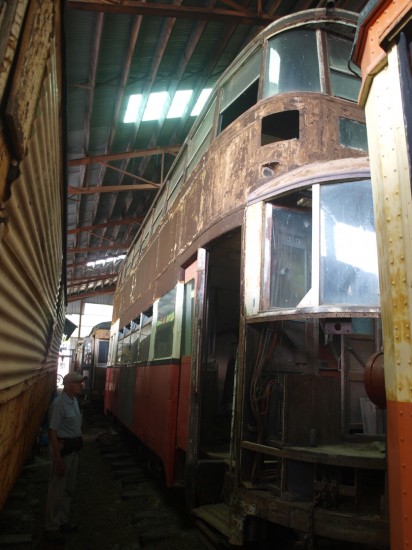
Our first view shows one side of Leeds 526 in the shed at the Seashore Trolley Museum. (Photo: Jamie Guest)
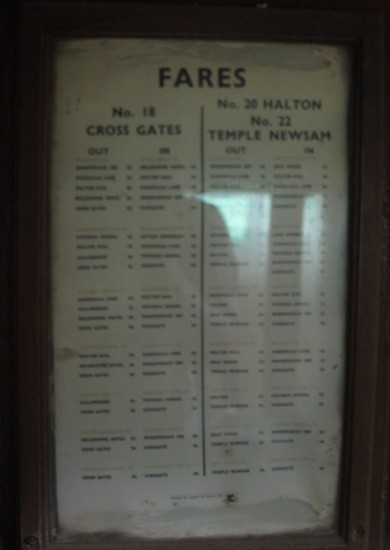
Even though the tram is in poor condition the fare table for the Cross Gates and Temple Newsam route is still in good condition if very hard to photograph. (Photo: Jamie Guest)
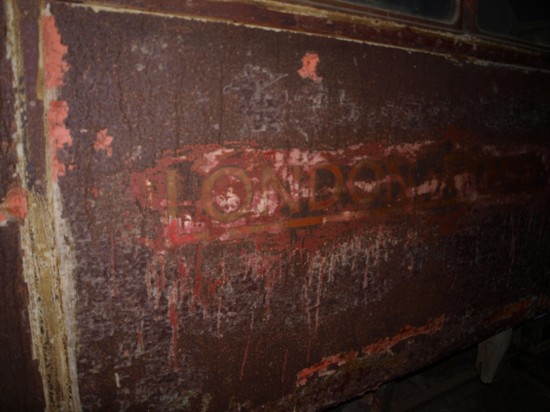
The London Transport livery is still visible on 2085 as it was in its days in the capital. (Photo: Jamie Guest)
* You can find out more about the Seashore Trolley Museum at http://www.trolleymuseum.org/index.php

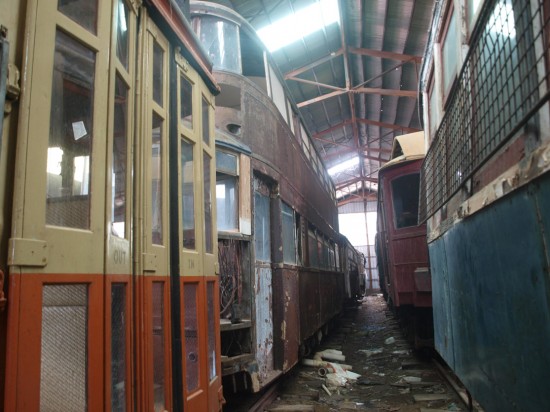
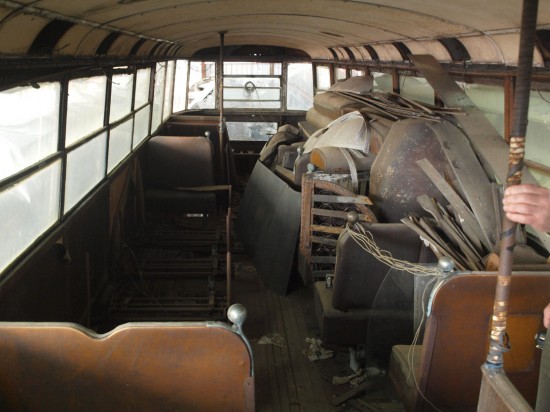
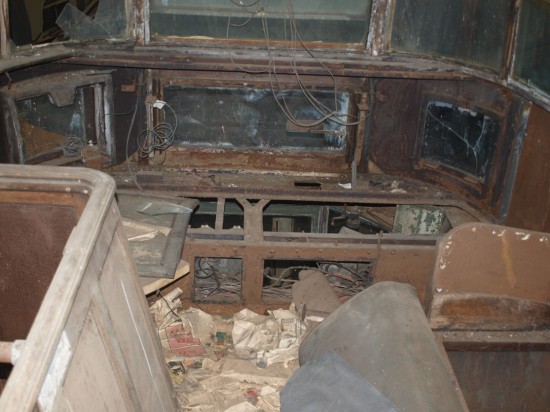
what a sad sight it is.
I have to ask if they are interested in the English cars. All the pictures of the running vehicles are American. The feltham and the Liverpool baby grand are in a pathetic state. Does any one have the money to bring them back before they turn to dust.
I lived in the US for many years and visited Seashore several times. Both the Feltham and especially the Liverpool tram were for some reason the ‘ugly sisters’ of the foreign tram collected by the Museum in the 50s and 60s. More or less ignored in unheated ‘barns’ they have certainly deteriorated since their arrival and indeed the question might well be asked if there is a viable future in a caring ‘home’ for this duo? I am working on a scheme to assemble a representative collection of trams as part of the Fleetwood Heritage Trust initiatives – and the Feltham tram in Leeds livery with a sponsor behind it is on our agenda. There are enough London trams including two ‘Felthams’ preserved in display condition – so this remaining example should certainly be a very worthwhile exhibit in the final operating role these trams filled ‘up north’. Any interested parties should get in touch with the Fleetwood Heritage Leisure Trust on our website or via BTO. I believe Liverpool 293 is too far gone to be a credible restoration project and the work at Birkenhead Museum is moving towards completion of sister car 245.
245 was also in a bad state courtessy the Southport preservation group. this has however been rebuilt by replacing a lot of the original. If 293 were returned the under frames should be useable along with some of the interiior and electrics that will need rewiring.
It has been suggested that a small group go out and flat pack it for shipping back but this would need sponsership to have the containers brought home.
The tram has some significance as the last tram to run in Liverpool in service and the paint job says it all.
Any offers
I would like to see 293 returned to the UK and restored. It seems a number of initiatives have started but stalled. Why doesn’t someone who knows how run appeals start one (I wouldn’t know where to start!) and give it plenty of publicity and approach potential sponsors for shipping etc. always supposing Seashore will let it go in the first place. Clearly it will never run again in the US. Incidently a number of narrow gauge steam locos taken to the US in the 60’s are now finding their way home.
Tragic to see a London tram rotting away, when there are only about ten London electric trams still in existence out of over 2500 that operated there.
Good grief ! What on Earth is this wonderful bit of British history doing rotting in America ? Surely there must be a nice rich British gentleman (or woman) who hates to see our lovely Great British history festering and rusting in a country which does not care a toss for it.
Come on Great Britain; how do we get this lovely beast home from the USA ?
Whilst I would love to see the car returned and restored and was sad to see it in the state it now is, I think we should be grateful that it is stored, undercover and safe from theft and vandalism. If this had not been done for the last 52 years it would have gone to the scrapyard with the remainder of it’s kind. Seashore have given it a home and we should be grateful for that. It is not alone and they have many more of their own cars that need restoration but for which the funding is not available.
Jamie
Very sad to see 526 in such poor condition, but thank you for the pictures. I have been wondering for years what it would look like, but reality did not match what was in my head!. I do agree however that Seashore have saved this tram, regardless of its present condition.
Having seen the pictures it is a shame that this tram is slowly disintegrating. They seem to be trying to get the Blackpool car running as shown on their website.
They seem to be more worried about the home grown cars but that is their prerogative.
If there is a concerted move to repatriate this car or the other British cars I would like to support it but would Seashore ever decide to let them go.
I do not think they could run due to profiling and of course the height restrictions. Look at the height of the trolley tower of the San Francisco boat. However, if Seashore had not got them they would have been scrapped.While we moan, Crich would not take all Blackpool Trams on offer because they could not find the money to build a depot. Be thankful that Seashore have these undercover no matter what the state of them.
Incidentally, the Blackpool boat at Rio Vista has been sidelined with motor problems which do not appear to be high on the repair list.
Another of the Blackpool Standards in America had its wooden panels replaced by metal panels on cost grounds but this one runs.
I was at Seashore some 20 years ago and I have identical photos of the Feltham. It seems somebody started restoration, took off one end and got scared. The ends were 1/8″ boiler plate! But it does not seem to have deteriorated in those intervening years. I also took photos of Liverpool 293, just the truck and the inside, including upstairs but I was very wary as it’s exceedingly rotten. I believe it was used as a billboard for the Museum and Maine weather is not the most forgiving.
Nice museum, nice folks.
Happy Days,
Mike Beard
Hi, is there any more information on this tram as to whether it is ever likely to return to the UK?
Richard,
It sadly seems unlikely. If anyone reading this is able to write a cheque for £700,000 to the Leeds Transport Historical Society, or the Tramway Museum Society, or the Fleetwood Heritage Leisure Trust, then it can happen. If not it won’t.
I was very interested in the latest reports on the second surviving Production Feltham. It looks in better condition than when I inspected the car in the 1990’s!!! LPTB 2085 was the first and only Feltham to be given a full post-war renovation at Charlton under the direction of Vic Matterface. It was so quiet and pristine that the Streatham depot staff nicknamed it the “Queen of Telford”, which name was painted in the cabs. Shortly on re-entry to service, someone at 55 Broadway saw, heard it and reported back to “Road Services” at a time when LPTB reopened the tram replacement topic. Needless-to-say the instruction to Charlton not to spend any money beyond ‘safe’ maintenance, was hastily given. Thus it is a special London Feltham and I had always wanted to see it in LPTB 1938 condition from Streatham depot.
I had estimated then a cost not exceeding £1m. to purchase, clear US Govt., shipping and transportation costs based on it going to Crich and into passenger service. I was concerned by some visual distortion to the integral metal structure possibly caused by on-deck stowage, but not confirmed.
It certainly needs a young man with the ability to generate that sort of cash if it is to succeed. Alas, I am now too old and therefore I am “out”.
Colin – never say never
I visit Seashore a few years back – they had 4 UK trams there, Sheffield, Glasgow, LT and Liverpool from memory, also Bus RTL1629. The bus had been used as a caravan and the owner died, that was in poor condition and the police had moved it there, in the open with roof caved in. At least the trams are undercover. The Feltham had shifted while crossing the Atlantic where most of the damage was done. But it needs to come back here!
There’s no Sheffield tram there- it’s blackpool standard 144. Liverpool 293 does look a little like a Sheffield car in its livery though.
I do apologise for the length of this comment, but a resumption of interest in this topic on this site has touched a nerve.
When Theodore Santarellli de Brasch showed up in a UK tram town at the end of the 1950s, it was a sure sign a system was in its last weeks. He travelled at his own expense representing the Seashore Trolley Museum of Kennebunkport, Maine at a time when this body wanted to assemble a representative collection of foreign cars to contrast with its North American fleet of home-gown vehicles and operating practices.
Liverpool, Leeds and Glasgow are the three places I recall his presence. Was he perhaps also at Aberdeen in 1958, the Swansea and Mumbles closure of 1960 (already imminent in October and November of 1959 when he put in an appearance at Leeds), Sheffield in the autumn of 1960 and at Grimsby and Immingham in 1961? Personally I don’t know.
Perhaps he was also involved in the earlier (1955) transfer of Blackpool Standard 144 to Seashore.
Seashore was the first-ever amateur trolley (tram) museum project (its origins go back to 1939), and is the only museum in North America with a national and international outlook rather than a regional view, though a bias towards its local Boston and New England area shines through.
Influential? Successful? I can’t give an objective answer and I doubt many others can. Certainly its restorations are tremendous (though museum purists will always raise the conservation /authenticity issue), its shop capabilities extensive, its museum site huge and the demonstration rides long and impressive.
But for me, however, the place is dominated by the scores of hulks around the grounds, eyesores to the average lay visitor of whom regrettably there have been less and less in recent years.
The hulks are the fruits of “Operation Last Round-up.” They have been “saved” for the moment, but the cost of their stabilization, never mind conservation, is daunting. It has overwhelmed the place for years. No matter how many vehicles are worked on, it seems to make little dent in those still waiting their turn-and some have waited over 50 years.
The UK cars, though under cover, are in a similar predicament and being foreigners are way, way down the priority chart. I strongly doubt the Feltham ever turned a wheel there, an assertion I make having quizzed the late Fred Perry (who supervised the car’s unloading in Boston and transport by road to Seashore in early 1960) a number of times. An attempt was made at a restoration in the mid-1970s. Unhappily it was a private venture and petered out.
Liverpool 293 acquired its present distressing condition early. When I first encountered it in 1965, it was little more than a billboard for the museum near the intersection of US 1 and the secondary road that meandered a mile or so to the museum’s main entrance.
Glasgow 1274 was test run for a very short distance when it arrived before it was realized it was out of gauge. It has been in the display barn ever since and is nowhere near as bad as the Feltham and Baby Grand, though undeniably it isn’t good either.
Blackpool 144’s wheel profiles should theoretically be more attuned to Seashore’s open (railway)-style track and it certainly was run on occasions from its arrival in 1955 until goodness knows when. When I visited in July 1965, it wasn’t in use, but after some enquiry I found I could charter it. So I did. Its meanderings were confined to the yards and a point up to the commencement of the main line. Always there was the fear of derailment. It didn’t happen in this case.
Up till now, Seahore’s official position on repatriation of these cars always been “Look, where were you when we bought them? They’re ours and their time here will come.” They have every right to make that claim.
But nothing is set in stone. Money always talks.
I believe any UK group interested in Seashore’s UK cars, needs first to assemble a credible package that would ensure adequate funding ($750,000 plus) and acceptable facilities for a restoration to presentable static or even running condition.
At that point the Seashore museum just might have some interest in discussing the matter further. Float a trial balloon and see.
Whether the restored cars would remain at Seashore or be removed for restoration on some form of long-term loan or other joint venture with Seashore for their display elsewhere, ideally somewhere in the UK, is anyone’s guess but would surely be part of the negotiations
Of course I’d like to see all of them back in the UK, properly done up. I don’t think I’m in a minority on that. But it should be a venture jointly with Seashore, from which that museum gets some benefit, whether it be an outright sale, a long-term loan, or something else entirely.
No guesses as to where to shoot for if this all comes to pass-Glasgow 1274 at Summerlee, Blackpool car (heritage fleet or Heaton Park), Liverpool car at Birkenhead or Beamish. But the Feltham? As a Leeds car? As a LT car? At Beamish? Carlton Colville? Blackpool heritage?
There are currently four Blackpool boat cars in the US, all with good homes. Three are in the Bay Area, 601 (226) at the Rio Vista Museum in California (don’t think it’s fit to run now, though) while 228 and 233 are with MUNI in San Francisco. Boat 606 (235) went to the now defunct Trolleyville museum in Ohio during the year 2000 in exchange for Standard 147 but is now happily settled down in the National Capital Trolley Museum in Wheaton, Maryland, just outside Washington DC.
But what about Howth 2 at Orange Empire in Perris CA? Well, it too has a good home and runs every now and again. Remedial work was done on it some time back, but both ends still droop. However, with due respect to its present owners, if money were ever available for a bit more TLC, the car could use it. Return to UK or Ireland? Doubtful.
Then there’s Blackpool Std 48 and the remains of the Blackpool Belle (toastrack 163) out in Oregon. Plenty of surviving Blackpool standards already, but another toast-rack in UK heritage service would be interesting, no? I have no notion of how amenable their present owners would be to such an arrangement.
Finally, there’s Burton & Ashby 14, a denizen of the former narrow-gauge Detroit tramway on Washington Avenue. The entire fleet of Lisbon cars plus a Vevey car and the B&A car have been mothballed for years since the line closed and subsequently was dismantled. There are rumours that the lot will be put up for auction by their owners, the agency that runs Detroit’s buses, in October.
Anyone in the UK interested? What about the Black Country Museum—indeed does the narrow-gauge tramway there still run? I can’t imagine 4-wheelers on the Manx Electric, let alone double-deckers so I can’t see any possibilities there.
But here’s the thing. Except for Burton & Ashby 14, all these cars are duplicates of types already in preservation in the UK.
Perhaps it would be money better spent to instead think of building replicas of UK cars that got away. My preference would be for vehicles of the late 1920s and especially the 1930s, these for their gee-whiz glamour that attracts lay audiences in their thousands, as much as for any technical developments.
Herewith then, for your entertainment, a provisional list. Overkill? Yes. Pie in the sky? Yes. But if only five of the cars listed should be reincarnated as accurate replicas, it will be a substantial achievement and money better spent than on repatriating vehicles that may still have a future with their U. S. owners.
Aberdeen. Bogie or single truck streamliner.
Bath. Open-top car.
Belfast. Macreary car.
Bradford. Rebuilding double-decker from Sheffield 330, whose grinding/ water function has been taken over at Crich by the Cardiff water car.
Birmingham. Last bogie car, lightweight 843.
Blackburn. Big bogie car.
Brighton. 1930s 4-wheeler.
Bristol. 4-wheeler.
Cardiff. Brush low-floor DD car. (Do any of their long single-deck cars sold to Manaos survive?)
Darwen. Streamliner.
Dublin. Deluxe bogie streamliner.
Dundee. Lochee car.
Edinburgh. Met-cam streamliner.
Glasgow. Streamlined 4-wheeler. (6, 1001-1004)
Halifax. Last cars built (1929-1931)
Huddersfield. 4-wheel streamliner.
Kinver LR. Single-deck open bogie car.
Leeds. Pivotal-trucked Chamberlain.
Leeds. Middleton bogie (rumours are one may be in contemplation).
Leeds. Lance Corporal.
Liverpool. Marks bogie or Cabin car.
Manchester. Big standard bogie (already under construction).
Manchester. Pullman (Pilcher) car.
Norwich. Open-top dd of 1925.
Rothesay. Ettrick Bay single-deck bogie.
Swansea. Mumbles electric car.
Sunderland. Centre-entrance 4-wheeler,
Sunderland. Ghost tram.
Thank you all for your patience.
A. D. Young
Very interesting point, but I would like to point out that a 1930’s brighton four wheeler is currently be restored, numbered 53.
My goodness, I didn’t realise that project was actually under way.
Thanks for pointing it out. It should be a fascinating car once completed.
A. D. YOung